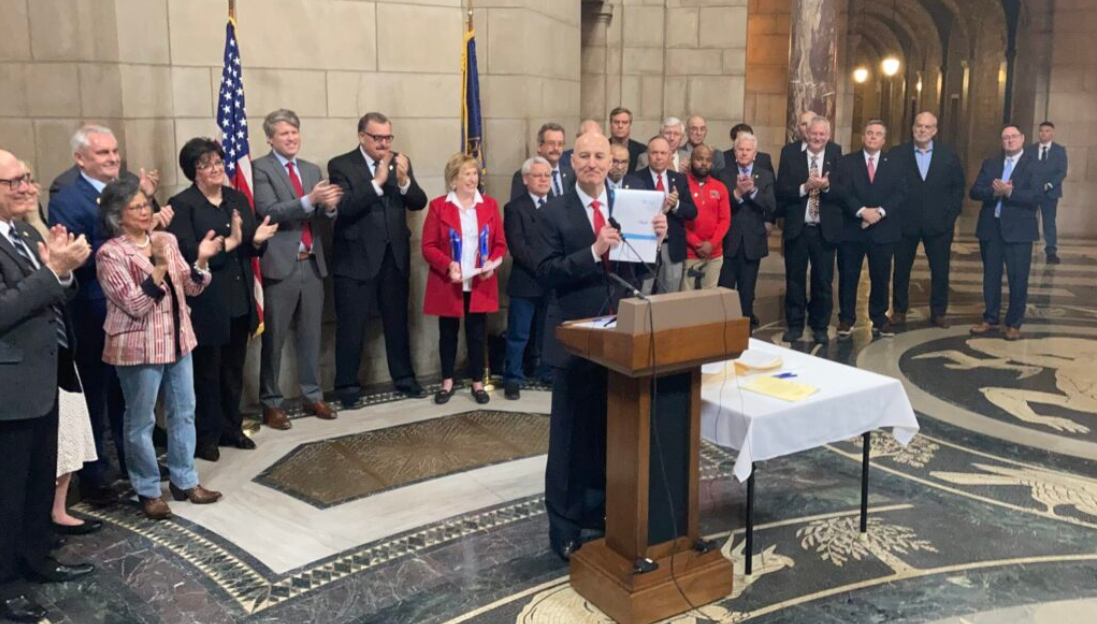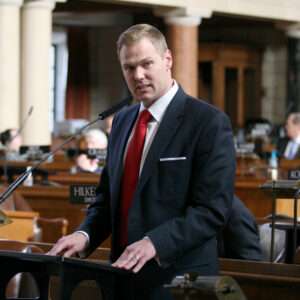
By PAUL HAMMEL
Nebraska Examiner
LINCOLN — Gov. Pete Ricketts took a victory lap Wednesday with supporters as he signed into law a comprehensive tax cut bill that is projected to provide $948 million in tax breaks a year by 2028.
During a ceremony in the State Capitol Rotunda, Ricketts said Legislative Bill 873 would add up to $3.4 billion in cumulative tax relief by 2027.
The Republican governor said that the yearly impact from the bill would be 12 times greater than any previous tax-cut bill passed by the Legislature.
‘It takes a lot of folks’
“It takes a lot of folks to get a historic bill like this over the finish line,” he said, as 25 state senators, along with legislative staffers and representatives of major business and farm groups looked on.
Critics of LB 873 have raised doubts about whether it reduced state revenues too deeply at a time when tax receipts have been propped up by billions in federal aid to combat the impacts of the COVID-19 pandemic. The OpenSky Policy Institute said the state may be forced to cut spending on education and roads in the end.

Opponents, led by State Sen. John Cavanaugh of Omaha, said the tax cuts primarily benefited wealthy Nebraskans and out-of-state corporations and granted no income tax breaks for couples earning less than about $60,000 a year.
But critics of the bill were nowhere to be found at Wednesday’s ceremony, in which the governor handed out ceremonial copies of LB 873 to representatives of several groups that backed the bill. Those included the Nebraska Chamber of Commerce and Industry, the Nebraska Farm Bureau, Union Pacific Railroad and the AARP.
‘Landmark’
Officials with those groups described LB 873 as “landmark,” “historic” and “truly large,” and they pledged that the measure would make Nebraska more competitive with its neighboring states in tax rates and in attracting businesses and workers.
“We’re not 34th out of 50 any longer,” said Bryan Slone, president of the State Chamber, referring to the state’s ranking in “business tax climate” by the Tax Foundation.
The foundation actually ranked Nebraska 35th among the states in its most recent ratings in December. The group gave the Cornhusker State its worst ranking in property taxes, 40th, while placing the state 29th in the country for individual income taxes and 32nd in corporate income taxes.
Business groups have argued for years that Nebraska’s top state income tax bracket of 6.84%, was too high compared to its neighbors, acted as a disincentive for skilled workers to move here and especially hurt small businesses, which often pay their taxes as individual income.
Iowa lowers its rate
Only Iowa, among Nebraska’s neighbors, has a higher top rate. But the Hawkeye State recently moved to reduce its state income taxes to 3.9%.
Under LB 873, Nebraska’s top income tax rate will drop to 5.84% after five years. In addition, the state’s top corporate income tax rate, now 7.81%, would fall to 5.84% by tax year 2027, which proponents said creates parity with small businesses.

In an effort to overcome filibusters blocking the income tax proposals, they were paired with a hugely popular proposal to speed up the phase-out of state income taxes on Social Security payments, which was introduced by Omaha Sen. Brett Lindstrom. A bill passed last year phased out such taxes over 10 years, while LB 873 does it sooner, by tax year 2025.
To garner more support from rural senators and farm groups, LB 873 also included additional state property tax credits.
More income tax credits
A current refundable state income tax credit provides about a 25% credit for property taxes paid to support K-12 schools. A compromise with rural senators added a new credit for property taxes paid to support community colleges, a credit that will grow to $195 million by 2026.
Dick Pierce, a representative of the Nebraska Cattlemen, said that group’s efforts to reduce property taxes on ranchers and farmers “is not over.”
“I think we can do better, but this is a step in the right direction,” Pierce said.

When asked about that, Ricketts — who will leave office in January — said Nebraska needs to change the way it values farmland from the current market system to one based on its income producing capability.
Elkhorn Sen. Lou Ann Linehan, who chairs the Legislature’s Revenue Committee, said Wednesday that both the state’s income taxes and property taxes are still too high. She added that LB 873 was based on very conservative estimates of its fiscal impact.
Ricketts, in comments after the ceremony, emphasized that the income tax cuts benefit 60% of Nebraskans. He said even those who won’t get income tax cuts will get indirect benefits via the property tax credits and elimination of taxes on Social Security.
Lee Will, the governor’s budget chief, said the next largest tax cut package was in 2012, which provided $56 million a year in breaks. Adjusted for inflation, Will said that package would amount to about $79 million by 2028, which compares to a projection of a $948 million tax break from LB 873.




